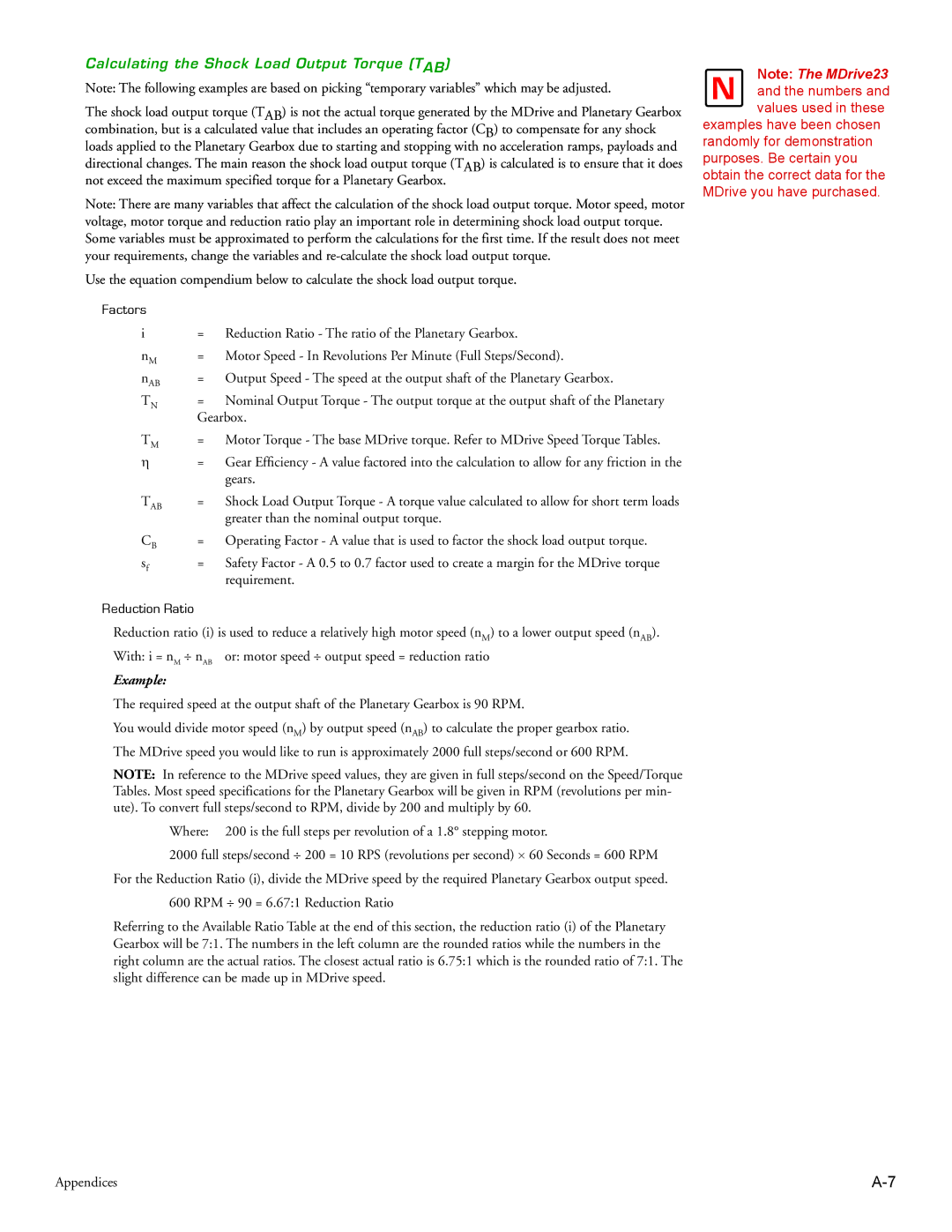Calculating the Shock Load Output Torque (TAB)
Note: The following examples are based on picking “temporary variables” which may be adjusted.
The shock load output torque (TAB) is not the actual torque generated by the MDrive and Planetary Gearbox combination, but is a calculated value that includes an operating factor (CB) to compensate for any shock loads applied to the Planetary Gearbox due to starting and stopping with no acceleration ramps, payloads and directional changes. The main reason the shock load output torque (TAB) is calculated is to ensure that it does not exceed the maximum specified torque for a Planetary Gearbox.
Note: There are many variables that affect the calculation of the shock load output torque. Motor speed, motor voltage, motor torque and reduction ratio play an important role in determining shock load output torque. Some variables must be approximated to perform the calculations for the first time. If the result does not meet your requirements, change the variables and
Use the equation compendium below to calculate the shock load output torque.
Factors |
|
i | = Reduction Ratio - The ratio of the Planetary Gearbox. |
nM | = Motor Speed - In Revolutions Per Minute (Full Steps/Second). |
nAB | = Output Speed - The speed at the output shaft of the Planetary Gearbox. |
TN | = Nominal Output Torque - The output torque at the output shaft of the Planetary |
| Gearbox. |
TM | = Motor Torque - The base MDrive torque. Refer to MDrive Speed Torque Tables. |
η= Gear Efficiency - A value factored into the calculation to allow for any friction in the gears.
TAB | = | Shock Load Output Torque - A torque value calculated to allow for short term loads |
|
| greater than the nominal output torque. |
CB | = | Operating Factor - A value that is used to factor the shock load output torque. |
sf | = | Safety Factor - A 0.5 to 0.7 factor used to create a margin for the MDrive torque |
|
| requirement. |
Reduction Ratio
Reduction ratio (i) is used to reduce a relatively high motor speed (nM) to a lower output speed (nAB). With: i = nM ⎟ nAB or: motor speed ⎟ output speed = reduction ratio
Example:
The required speed at the output shaft of the Planetary Gearbox is 90 RPM.
You would divide motor speed (nM) by output speed (nAB) to calculate the proper gearbox ratio. The MDrive speed you would like to run is approximately 2000 full steps/second or 600 RPM.
NOTE: In reference to the MDrive speed values, they are given in full steps/second on the Speed/Torque Tables. Most speed specifications for the Planetary Gearbox will be given in RPM (revolutions per min- ute). To convert full steps/second to RPM, divide by 200 and multiply by 60.
Where: 200 is the full steps per revolution of a 1.8° stepping motor.
2000 full steps/second ⎟ 200 = 10 RPS (revolutions per second) ⋅ 60 Seconds = 600 RPM
For the Reduction Ratio (i), divide the MDrive speed by the required Planetary Gearbox output speed. 600 RPM ⎟ 90 = 6.67:1 Reduction Ratio
Referring to the Available Ratio Table at the end of this section, the reduction ratio (i) of the Planetary Gearbox will be 7:1. The numbers in the left column are the rounded ratios while the numbers in the right column are the actual ratios. The closest actual ratio is 6.75:1 which is the rounded ratio of 7:1. The slight difference can be made up in MDrive speed.
Note: The MDrive23 and the numbers and values used in these
examples have been chosen randomly for demonstration purposes. Be certain you obtain the correct data for the MDrive you have purchased.
Appendices |
